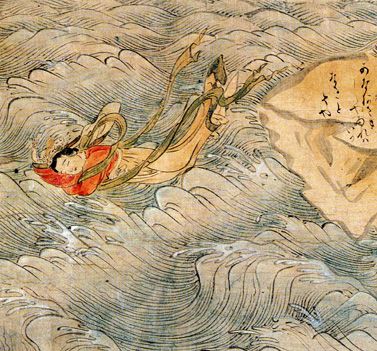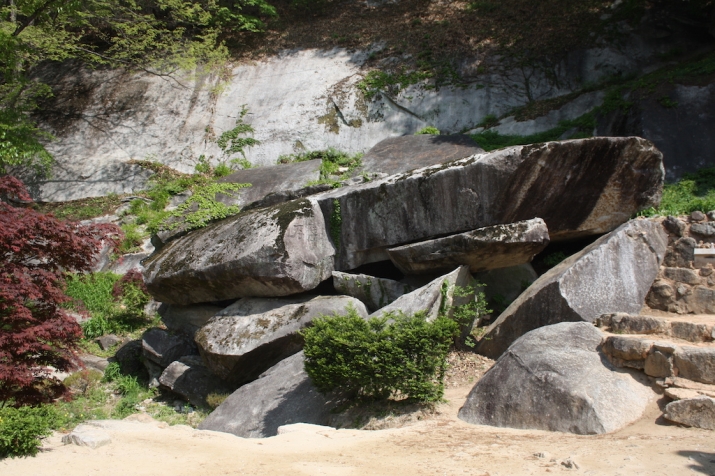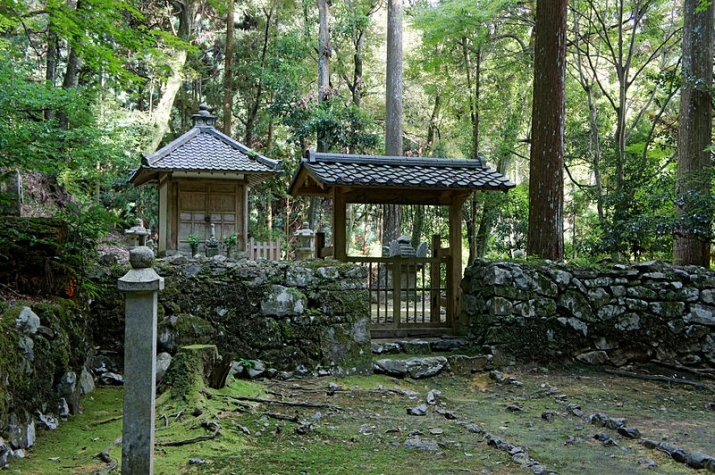FEATURES|THEMES|Books and Literature
The Dragon-girl and Her Monks: Shanmiao’s Relationships with Uisang and Myoe
Buddhistdoor Global | 2015-04-10 |

Shanmiao meets Uisang. From geocities.jp/noharakamemushi
In the temple Kozan-ji in Kyoto is a 750-year-old collection of scrolls that is designated a National Treasure. The third scroll, the Illustrated Scroll on the Origins of Huayan/Kegon (J. Kegon engi emaki), depicts a majestic female dragon carrying a boat on its back through stormy waves. On the boat is the monk Uisang (625–702), the first patriarch of the Huayan (K. Hwaom) tradition in Korea. The fierce dragon was originally a remarkable human girl called Shanmiao (J. Zenmyo). Appearing variously as a human woman, a dragon, and a stone, Shanmiao helped Uisang establish himself as a teacher of Hwaom. She later wielded romantic sway over the influential abbot of Kozan-ji, Myoe (1173–1232). Shanmiao is one of those figures on the nebulous border of human memory and imagination—an archetypal myth that exerted a very real influence over two historical Buddhist leaders.
We are told in the scroll (and in the Korean collection of mythic-historical accounts, Samguk yusa) that Shanmiao was the Chinese Tang-era (618–907) daughter of a Buddhist merchant who hosted Uisang during his studies of Huayan in China. Shanmiao fell deeply in love with Uisang, who kindly but firmly rejected her—and apparently even managed to convert her to Buddhism. Later on, having traveled around China, Uisang returned to her port town on his way back to Korea. Hearing the news, Shanmiao was delighted at the prospect of seeing him again and rushed to the harbor, but his ship had already set sail. Distraught, Shanmiao threw her belongings and herself into the sea, but miraculously transformed into the Illustrated Scroll’s splendid dragon, protecting Uisang all the way home.

Shanmiao jumps into the ocean. From geocities.jp/noharakamemushi
In 676, having arrived back in Korea, Uisang complained of “heretic” monks at a monastery he wished to move into, located near the beautiful Mt. Bonghwang in today’s Yeongju city. Eager to help, Shanmiao turned into a large rock that hovered mid-air above the monastery. The heretics fled in fear, and Shanmiao would forever after protect Uisang and his temple. Uisang, in return, named it the “Monastery of the Floating Rock,” or Buseoksa. Korean folklore asserts that the Muryangsujeon hall (National Treasure No. 18) at Buseoksa, the second-oldest standing wooden structure in South Korea, was the location of Shanmiao’s second transformation. There is indeed a rock that seems to “float” somewhat above the ground next to Muryangsujeon, although not nearly as high as the legend claims.
Nevertheless, turning into a rock or dragon at will is no mean feat in East Asian lore. What is particularly bizarre is that the human Shanmiao is never revealed to possess any magical powers. We only know that she is extremely upset by Uisang’s departure and jumps into the sea, and from then on the story takes for granted that we accept that she is a supernatural shape-shifter. It is difficult to deny that we are looking at a rather extraordinary girl, one who seems to embody, quite literally, the cliché that with love, anything is possible.

Shanmiao carries Uisang’s ship to Korea. From junsky07.blog89.fc2.com

Shanmiao carries Uisang’s ship to Korea. From junsky07.blog89.fc2.com
In his book The Red Thread: Buddhist Approaches to Sexuality, (1998), Bernard Faure refocuses much-needed attention on Shanmiao’s relationships with Uisang and Myoe. Myoe, one of Kamakura Japan’s best Kegon monks and a handsome man in frequent contact with female devotees, was profoundly affected by the story of Uisang and Shanmiao: he is also thought to have initiated the making of the Kegon engi emaki. He personally admired the Korean master and wanted to go to China to study Buddhism (unlike Uisang, however, he was never able to do so). Shanmiao was also an attractive but safe fantasy: yes, the Chinese girl was a lover, romantically attracted to a celibate man, but in the great tradition of women who adored the quintessential ladies’ monk, the Buddha’s cousin Ananda, Shanmiao followed the well-worn literary trope of becoming a disciple-cum-protector after Uisang’s rejection.
The bond between Uisang and Shanmiao seems to have affected the reverie-prone Myoe so much that he had a dream about her. His dreams are recorded in his Dream Diary (J. Koben yume-no-ki), which is also stored at Kozan-ji. In the diary he confesses to different dreams of sex with upper-class noblewomen and court ladies despite his lifelong celibacy (Faure 1996, 125). Myoe’s dream of Shanmiao also has strong sexual connotations, and betrays hints of Freudian sublimation and “secondary elaboration” (the outcome of the dreamer’s tendency to make some sort of “sense” or “story” out of the elements of recollected content).
In the dream, Myoe discovers a Chinese-made doll that tells him of its sorrow at having left its native land. When he promises to help the doll, it transforms in his hands into a real crying maiden. The thrilled monastic takes her into his care, but when they attend a Buddhist ritual another priest accuses the girl of having slept with snakes. Myoe leaps to her defense, arguing that she has a reptilian form (that her actual being is supernatural) and is innocent of sex with snakes. On waking, Myoe concludes that the girl was none other than Shanmiao (the ontology of snakes and dragons in medieval Japan being often blurred).
 The purported floating rock at Muryangsujeon, Buseoksa Temple. From thedowiestravel.wordpress.com
The purported floating rock at Muryangsujeon, Buseoksa Temple. From thedowiestravel.wordpress.comWe will never know whether it was truly Shanmiao who appeared to Myoe. Perhaps she saw him as a sympathetic figure worthy of new affections—Myoe, after all, lived several centuries after Uisang. Myoe also did something praiseworthy with his fantasy of Shanmiao, founding a nunnery in 1221 to serve as a refuge for women who had lost their husbands in the Jokyu War. He named this sub-temple of Kozan-ji Zenmyo-ji, installing an image of Shanmiao as its main object of worship (J. honzon). However, since she was the protector of Uisang’s temple in Korea, Myoe enshrined Shanmiao as a protective deity from Silla (Korea) rather than China. Myoe’s attachment to Shanmiao was redirected into an act that had spiritual meaning. Her physical connection as protector of Myoe’s religious community at Kozan-ji reflects the ties between her and Buseoksa: a tangible bond with an intangible character at the twilight boundary between lore and fact.
Did Myoe, like some lonely men do, simply dream an imaginary woman into his life, or did Shanmiao really feel drawn to him as she was to her Korean sweetheart? For us in 2015, Shanmiao is a personality hiding behind a veil, and we cannot know whether that veil is woven by fancy or reality—or both. We only know that so strong was the bond between these two historical figures and this female archetype that it seems her story cannot be separated from their contributions to Korean and Japanese Buddhism.
One last, eerie historical reality gives us pause to linger on Shanmiao’s presence in Uisang and Myoe’s lives, real or imagined. After Myoe’s death, some of the nuns in his care drowned themselves by throwing themselves into Kiyotaki River, near Zenmyo-ji. One of them is recorded in 1232 as a nun called Myotatsu, who jumped into the river six months after Myoe’s passing (Okuda 1997). Was Myotatsu following Shanmiao’s example, as George Tanabe has argued (Tanabe 1992, 131–35)? Were these nuns sacrificing themselves to pursue Myoe unto death and to the ends of the earth?
 Myoe's grave at Kozan-ji. From Wikimedia Commons
Myoe's grave at Kozan-ji. From Wikimedia CommonsReferences
Faure, Bernard. 1996. Visions of Power: Imagining Medieval Japanese Buddhism. Princeton, New Jersey: Princeton University Press.
———. 1998. The Red Thread: Buddhist Approaches to Sexuality. Princeton, New Jersey: Princeton University Press.
———. 2007. “Kegon and Dragons: A Mythological Approach to Huayan Doctrine.” In Reflecting Mirrors: Perspectives on Huayan Buddhism, edited by Imre Hamar, 297–307. Wiesbaden: Harrassowitz Verlag.
Okuda, Isao. 1997. “Myoe to josei: Kegon engi, Zenmyo, Zenmyoji.” Shoshin joshi daigaku ronso 89: 31–51.
Tanabe Jr., George J. 1992. Myoe the Dreamkeeper: Fantasy and Knowledge in Early Kamakura Buddhism. Cambridge, Massachusetts: Harvard University Press.
For more information, see:
Legends of the Kyoto Kegon Sect (Kyoto National Museum)

Categories:
Comments:
Share your thoughts:













